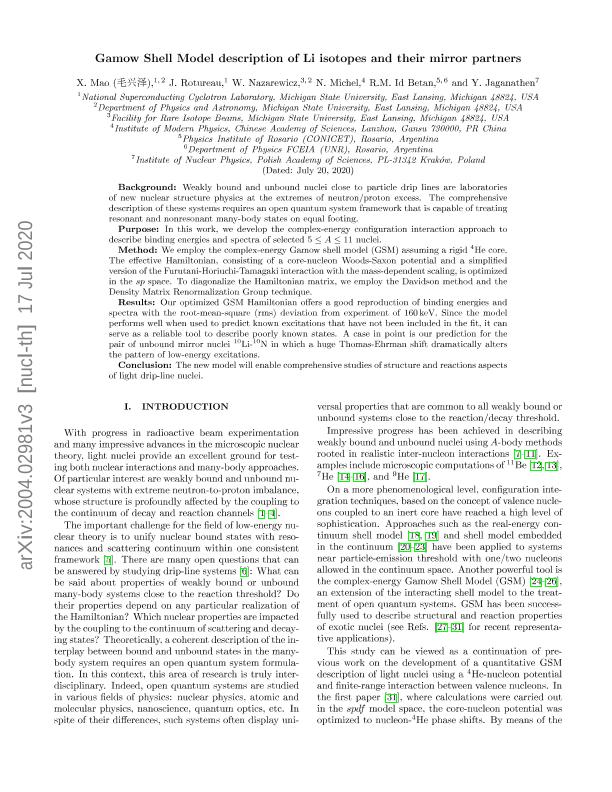Mostrar el registro sencillo del ítem
dc.contributor.author
Mao, X.
dc.contributor.author
Rotureau, J.
dc.contributor.author
Nazarewicz, W.
dc.contributor.author
Michel, N.
dc.contributor.author
Id Betan, Rodolfo Mohamed

dc.contributor.author
Jaganathen, Y.
dc.date.available
2023-01-05T23:03:08Z
dc.date.issued
2020-08
dc.identifier.citation
Mao, X.; Rotureau, J.; Nazarewicz, W.; Michel, N.; Id Betan, Rodolfo Mohamed; et al.; Gamow-shell-model description of Li isotopes and their mirror partners; American Physical Society; Physical Review C: Nuclear Physics; 102; 2; 8-2020; 243091-2430910
dc.identifier.issn
2469-9985
dc.identifier.uri
http://hdl.handle.net/11336/183639
dc.description.abstract
Background: Weakly bound and unbound nuclei close to particle drip lines are laboratories of new nuclear structure physics at the extremes of neutron/proton excess. The comprehensive description of these systems requires an open quantum system framework that is capable of treating resonant and nonresonant many-body states on equal footing. Purpose: In this work, we develop the complex-energy configuration interaction approach to describe binding energies and spectra of selected 5 ≤ A ≤ 11 nuclei. Method: We employ the complex-energy Gamow shell model (GSM) assuming a rigid 4He core. The effective Hamiltonian, consisting of a core-nucleon Woods-Saxon potential and a simplified version of the Furutani-Horiuchi-Tamagaki interaction with the mass-dependent scaling, is optimized in the sp space. To diagonalize the Hamiltonian matrix, we employ the Davidson method and the Density Matrix Renormalization Group technique. Results: Our optimized GSM Hamiltonian offers a good reproduction of binding energies and spectra with the root-mean-square (rms) deviation from experiment of 160 keV. Since the model performs well when used to predict known excitations that have not been included in the fit, it can serve as a reliable tool to describe poorly known states. A case in point is our prediction for the pair of unbound mirror nuclei 10Li-10N in which a huge Thomas-Ehrman shift dramatically alters the pattern of low-energy excitations. Conclusion: The new model will enable comprehensive studies of structure and reactions aspects of light drip-line nuclei.
dc.format
application/pdf
dc.language.iso
eng
dc.publisher
American Physical Society

dc.rights
info:eu-repo/semantics/openAccess
dc.rights.uri
https://creativecommons.org/licenses/by-nc-sa/2.5/ar/
dc.subject
Gamow Shell Model
dc.subject
Drip line nuclei
dc.subject
Optimization
dc.subject.classification
Física Nuclear

dc.subject.classification
Ciencias Físicas

dc.subject.classification
CIENCIAS NATURALES Y EXACTAS

dc.title
Gamow-shell-model description of Li isotopes and their mirror partners
dc.type
info:eu-repo/semantics/article
dc.type
info:ar-repo/semantics/artículo
dc.type
info:eu-repo/semantics/publishedVersion
dc.date.updated
2021-09-06T20:59:13Z
dc.identifier.eissn
2469-9993
dc.journal.volume
102
dc.journal.number
2
dc.journal.pagination
243091-2430910
dc.journal.pais
Estados Unidos

dc.description.fil
Fil: Mao, X.. Michigan State University; Estados Unidos
dc.description.fil
Fil: Rotureau, J.. Michigan State University; Estados Unidos
dc.description.fil
Fil: Nazarewicz, W.. Michigan State University; Estados Unidos
dc.description.fil
Fil: Michel, N.. Chinese Academy of Sciences; República de China
dc.description.fil
Fil: Id Betan, Rodolfo Mohamed. Consejo Nacional de Investigaciones Científicas y Técnicas; Argentina. Universidad Nacional de Rosario; Argentina
dc.description.fil
Fil: Jaganathen, Y.. Polish Academy of Sciences; Argentina
dc.journal.title
Physical Review C: Nuclear Physics

dc.relation.alternativeid
info:eu-repo/semantics/altIdentifier/doi/http://dx.doi.org/10.1103/PhysRevC.102.024309
dc.relation.alternativeid
info:eu-repo/semantics/altIdentifier/url/https://journals.aps.org/prc/abstract/10.1103/PhysRevC.102.024309
dc.relation.alternativeid
info:eu-repo/semantics/altIdentifier/url/https://arxiv.org/pdf/2004.02981.pdf
Archivos asociados
